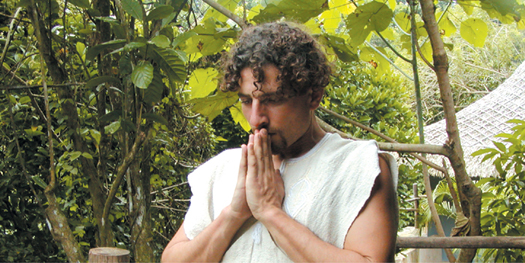
“AND THE LORD GOD FORMED MAN OF THE DUST OF THE GROUND AND BREATHED INTO HIS NOSTRILS THE BREATH OF LIFE; AND MAN BECAME A LIVING SOUL.”
— Genesis 2:7
“FOR THE RHYTHM OF THY BREATH IS THE KEY OF KNOWLEDGE WHICH DOTH REVEAL THE HOLY LAW.”
— The Essene Gospel of Peace, Book I
I have provided you thus far with a detailed treatise on how to lighten the diet to liberate more energy for achievement, but before I go further, let me tell you: Do not be deceived — little energy comes from food — stimulation comes from food. The digestion of food takes energy away from the body. Energy comes first from the spirit, and then primarily from the air — from oxygen — and from a lack of obstructions in the body. A lack of oxygen makes people weak, and food is what they turn to for strength (stimulation). For more energy, start breathing!
All scientific considerations aside, air contains some life principle (prana) that keeps the human body functioning. Prana is not oxygen, but etherealized monoatomic elements or something even more exotic. These etherealized elements are spirally unzipped out of the air and into our bodies by the act of breathing. Isn’t that fascinating?
When you sleep you automatically breathe, but you do not automatically eat! One can live for weeks without eating, for days without drinking, but only fleeting minutes without breathing. Yet breathing is the most neglected science in the health field. All other organs operate to keep the lungs functioning. The lungs, in turn, keep the internal organs healthy by pushing and squeezing them, allowing the fluids to move around, within and through them.
Every breath contains more air by weight than would be eaten at a typical meal, and we are taking thousands of breaths a day! One is just as poisoned by toxic air as by toxic food.
The power of breath is four-fold:
First and foremost, the breath controls the energy level in the body. We know that everything is energy — matter is just a form of frozen energy. The more oxygen and etherealized matter available to your cells, the more energy you have to accomplish your goals and the less food you desire. Many people overeat because they are not breathing deeply.
If you feel hungry, sick, tired or worn out, a good way for you to quickly rejuvenate yourself is to go outside and take 30 deep diaphragmatic breaths.
Second is the fact that the lungs play a major role in the human immune system. The lungs are the pump for the lymph system. There is four times as much lymph fluid in the body as blood; lymph bathes every cell of the body. As long as the lymph is kept clean and pumping through the body in an orderly fashion by daily deep breathing, the immune system will become incredibly strong.
Deep breathing alkalizes the body by removing carbonic acid (dissolved carbon dioxide) from the blood and lymph.
Third, controlling the breath allows you to begin to also control the so-called autonomic (automatic) functions of the body (i.e. heart rate, blood flow, body temperature, etc.). The yogis of India have long-known that every state of the mind and body is associated with a corresponding respiration pattern. Long slow breaths slow the heart (that is why Ehret called the heart a valve, not a pump). Deep breathing warms you up. If you feel cold by eating raw foods, then take deep breaths to warm your body. Take deep breaths to increase your inner “fire” energy.

The control of breath is the first essence of yoga.
Fourth, oxygen eliminates pain. Pain in the body is always associated with a lack of oxygen in that area. Athletes who strain a muscle often continue to play, in fact prefer to play, because by staying active the strained muscle remains oxygenated and will be less painful. One can find relief from backaches and sore muscles by deep breathing.
It is the control we exert over our own breath that most distinguishes humans from the other primates. The primary mammal groups that can control their breath are those with aquatic characteristics, such as the dolphin, the hippo, the seal, the whale and even the elephant.
Longevity is associated with slowing the breath. Those species that breathe very slowly live the longest. The giant tortoise breathes only four times a minute. Humans in comparison, breathe 18 times a minute, and a restless monkey 32 times a minute.
While breathing in through your nose, hold your mouth lightly closed, and leave your tongue comfortably pressed to the roof of your mouth. Ideas and inspiration come to us by breathing through the nose. Experiment with making your breathing so slow that it would not disturb a feather on your nose.
Exhaling is more important than inhaling. To fully help detoxify the body, blow out all the air from the bottom of the lungs then hold your breath. The vacuum produced in the lungs will exert a drawing force that pulls poisons from the blood into the lungs for elimination.
A rarely discussed reason why people become addicted to smoking cigarettes derives from the breath control that smoking entails. When someone smokes a cigarette they fall into a habitual breathing pattern that fundamentally alters their state and energy level until they feel “relaxed.” Practicing deep breathing helps overcome addictions to smoking.
By breathing deeper and more rhythmically, you become calmer and can concentrate and work better. Slow, deep diaphragmatic breathing was the first health discipline I really practiced consistently for years. I credit late-night deep breathing exercises with improving my performance in college when I was studying engineering. I often would need an additional two extra hours every night to do work, so at midnight I would go outside and do at least ten deep diaphragmatic breaths in the 1:4:2 ratio described on the next page. From this practice my mind would clear and my energy would soar.
We are breathing all night as we sleep and the exhaled carbon dioxide accumulates in stuffy homes. Keep your home windows open as much as possible, especially at night to allow fresh oxygen to continuously revitalize you. Consider, bringing a plethora of house plants into your bedroom and home to provide you with fresh oxygen.
Breathing is our most vital experience. Be silent, breathe deep. Silence is power. Silence is an art. Long life is a matter of deep rhythmic breathing and keeping extremely quiet. Be silent and you allow your conscious, doubting, warring mind to listen. The best performers have the calmest breathing and quietest minds during the moment of truth.
1 In my opinion, the best pattern for deep diaphragmatic breathing, which I have used daily since age 19, is the following 1:4:2 ratio:
• Breathe in (through the nose), for a multiple of one count. The nose simultaneously filters and humidifies the air we breathe. The cribriform plate above the septum in the nose also regulates the temperature of the air entering the lungs.
• Hold that breath, for a multiple of four counts. This fully oxygenates and stimulates the body.
• Breathe out (through the mouth), for a multiple of two counts. The out breath releases toxins.
An example of this breathing ratio:
• Breathe in for 6 seconds.
• Hold that breath for 24 seconds.
• Breathe out for 12 seconds.
2 I have also had much success with the following 1:1:1:1 yogic breath ratio:
• Breathe in (through the nose), for a multiple of one count.
• Hold that breath, for a multiple of one count.
• Breathe out (through the mouth), for a multiple of one count.
• Hold the lungs empty, for a multiple of one count. This creates a vacuum suction that draws toxins out of the tissues on the following inhalation.
An example of this breathing ratio: Breathe in for 6 seconds.
• Hold that breath for 6 seconds.
• Breathe out for 6 seconds.
• Hold the lungs empty for 6 seconds.
3 Practice 30 deep diaphragmatic breaths each day following either of these patterns, or both. Tune your lungs to these patterns. Initially, some dizziness and light-headedness may be experienced by breathing in this fashion as the brain becomes fully oxygenated; but this phenomena will pass as the body grows accustomed to deep breathing practices.
